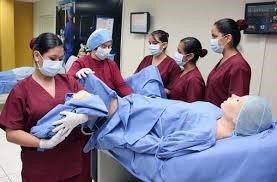University characteristics associated with the award of places for midwives in the peruvian rural service
Características universitarias asociadas a la adjudicación de plazas para obstetras en el servicio rural peruano
DOI:
https://doi.org/10.25176/RFMH.v20i2.2897Keywords:
Educational measurement, Health education, Midwifery, PeruAbstract
Objective: To determine the university characteristics associated with the allocation of place for obstetricians in the Rural and Urban Marginal Service in Health (SERUMS), 2019. Material and Methods: secondary base analysis obtained from the Peruvian Ministry of Health, where 506 obstetrics licenses were selected who submitted the National Obstetrics Exam (ENAOBS) and who have applied to SERUMS in the 2019-2 call. The characteristics of the universities where the obstetricians come from, the score obtained in the national and university exam and if it is suitable for SERUMS were evaluated. For the bivariate analysis it will be used in the Students T, ANOVA and Pearsons Correlation tests, while to adjust the model a logistic regression was performed, a 95% confidence level. Results: The obstetrics graduate visited mostly from a private university (66.01%), from the Lima region (41.7%) and applied for the paid modality (99.41%). It was found that 49.61% [95%CI: 45.23-53.98] were suitable for SERUMS. The average university qualification was 13.87 ± 1.35 and that of the ENAOBS was 10.93 ± 2.02, which had a significant correlation (p<0.001) that had a greater slope in graduates of public university (R=0.56). Belonging to a public university (OR=2.62) and studying in Lima (OR=1.49) were significantly associated (p<0.01) to be able to perform SERUMS in obstetrics. Conclusions: Being a graduate in obstetrics from a public university and studying in Lima gives you a better chance of being able to award a place in the SERUMS.
Downloads
References
2. Razo-Abundis IY, Dibut-Toledo LS, Íñigo-Bajo ER. Aseguramiento de la calidad en la educación superior: experiencia de la universidad del golfo de California, México. Revista Universidad y Sociedad. 2016; 8(1). Disponible en: http://scielo.sld.cu/scielo.php?script=sci_arttext&pid=S2218-36202016000100028
3. Superintendencia Nacional de Educación. Universidades: Públicas y privadas. [Página web] Lima, Perú. Citado el 22 de Noviembre del 2019. Disponible en: https://www.sunedu.gob.pe/lista-universidades/
4. El Peruano. Oficializan el Examen Nacional de Obstetricia. Resolución Ministerial Nº 422-2016-MINSA.2016. Lima, Perú. 16 Junio del 2016. Disponible en web:
https://busquedas.elperuano.pe/normaslegales/oficializan-el-examen-nacional-de-obstetricia-enaobs-resolucion-ministerial-no-422-2016minsa-1393796-1/
5. Universidad de San Martin de Porres. Asociación Peruana de Escuelas y Facultades de Obstetricia ASPEFOBST desarrolló Segundo Examen Nacional de Obstetras. [Página web] Citado el 22 de Noviembre 2019. Disponible en web: https://www.usmp.edu.pe/index.php?pag=novedades&sec=nov19_22
6. Mejia CR, Valladares-Garrido MJ, Romero BM, Valladares-Garrido D, Linares-Reyes E. Accidentes laborales asociados al desánimo de médicos SERUMS para
laborar en el primer nivel de atención de Lima, Perú. Revista Mexicana del Instituto Mexicano del Seguro Social. 2017; 55(6). Disponible: https://www.medigraphic.com/cgi-bin/new/resumen.cgi?IDARTICULO=76440
7. Mejia C, Quiñones-Laveriano DM. SERUMS y la migración de médicos: a propósito de una cohorte de médicos de Lima. Rev Per Med Exp Salud Pública. 2015; 32(2). Disponible en: http://www.scielo.org.pe/scielo.php?pid=S1726-46342015000200037&script=sci_arttext&tlng=pt
8. Mejia C, Inga-Berrospi F, Albrecht-Lezama C, Quispe-García AA. Problemas laborales en plazas del Servicio Rural Urbano-Marginal en Salud (SERUMS): auto-reporte de los médicos. Acta Médica Peruana. 2016; 33(1). Disponible en: https://www.redalyc.org/pdf/966/96645712014.pdf
9. Mujica O, Pereira-Victorio CJ, Munayco C. Sobre el impacto redistributivo del SERUMS en la disponibilidad de médicos en Perú. Rev Per Med Exp Salud
Pública. 2015; 32(1): 191-204. Disponible en: https://www.scielosp.org/pdf/rpmesp/2015.v32n1/193-194/es
10. Mayta-Tristán P, Poterico J, Galán-Rodas E, Raa-Ortiz D. ¿Existe equidad injusta por la eliminación del requisito obligatorio del Serums? Rev Per Med Exp Salud
Pública. 2015; 32(1): 191-204. Disponible en: https://www.scielosp.org/pdf/rpmesp/2015.v32n1/195-196/es
11. Taype-Rondán A, Alfaro-Toloza P. Falencias en el sistema de adjudicación de plazas del Servicio Rural Urbano Marginal en Salud en el Perú. Rev Med Hered.
2015; 26(2). Disponible en: http://www.scielo.org.pe/scielo.php?pid=S1018-130X2015000200010&script=sci_arttext
12. Ministerio de Salud. Serums: Proceso 2019. Dirección general de personal de salud. [Página web] Lima, Perú. Citado el 22 de Noviembre del 2019. Disponible en: https://www.minsa.gob.pe/dggdrh/comunicate/antes.html
13. Diario La República. ¿Particular o nacional? [Página web] Lima, Perú. Citado el 22 de Noviembre del 2016. Disponible en: https://larepublica.pe/archivo/327743-
particular-o-nacional/
14. Macknight AD. What determines the physiology that students learn? Advances in Physiology Education. 2019; 43(2): 172-174. DOI: https://doi.org/10.1152/advan.00035.2019
15. Rodrigues-Marques M, Monteiro LM, Dos Santos M, Pessoa B, Da Mota M, dos Reis RS. Risk and prevalence of anemia among women attending public and
private universities. Ecol Food Nutr. 2015; 54(5): 520-8. DOI: https://doi.org/10.1080/03670244.2015.1037442
16. Alves G, Cardoso-Ferreira MB, Neves-Nunes L, Marques-Ribeiro MF. Pedagogical training profile of basic health sciences faculty in biomedical and related fields at Brazilian public and private higher education institutions. Advances in Physiology Education. 2019; 43(29): 180-190. DOI: https://doi.org/10.1152/advan.00211.2018
17. 17. Mejía-Navarrete J. El proceso de la educación superior en el Perú: La descolonialidad del saber universitario. Cinta de Moebio. 2018; 61(1): 56-71. DOI:
http://dx.doi.org/10.4067/S0717-554X2018000100056
19. Espinosa O. Educación superior para indígenas de la Amazonía peruana: balance y desafíos. Anthropologica. 2017; 35(39). DOI: http://dx.doi.org/10.18800/anthropologica.201702.005
20. Parker PD, Jerrim J, Anders J, Astell-Burt T. Does Living Closer to a University Increase Educational Attainment? A Longitudinal Study of Aspirations, University
Entry, and Elite University Enrolment of Australian Youth. J Youth Adolesc. 2016; 45(69): 1156-75. DOI: https://doi.org/10.1007/s10964-015-0386-x
21. Hendrick CE, Cohen AK, Deardorff J, Duncan-Cance J. Biological and socio-cultural factors during the school years predicting women’s lifetime educational
attainment. J Sch Health. 2016; 86(3): 215-224. DOI: https://doi.org/10.1111/josh.12368
22. Carrasco-Cortez V, Lozano-Salazar E, Velásquez-Pancca E. Análisis actual y prospectivo de la oferta y demanda de médicos en el Perú 2005-2011. Acta
Médica Peruana. 2008; 25(1). Disponible en: http://www.scielo.org.pe/scielo.php?script=sci_arttext&pid=S1728-59172008000100005

Downloads
Published
How to Cite
Issue
Section
License
Copyright (c) 2020 Revista de la Facultad de Medicina Humana

This work is licensed under a Creative Commons Attribution 4.0 International License.



































